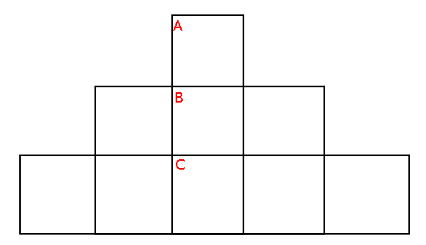Triangular Tic-Tac-Toe

Alice and Bob are playing Tic-Tac-Toe on the above triangular board. They play as in in normal Tic-Tac-Toe: taking turns, each player claims one square. The first to claim three squares in a row (vertically, horizontally, or diagonally) wins.
Alice plays first. Alice and Bob both want to win and play optimally. Which of the following is true?
This section requires Javascript.
You are seeing this because something didn't load right. We suggest you, (a) try
refreshing the page, (b) enabling javascript if it is disabled on your browser and,
finally, (c)
loading the
non-javascript version of this page
. We're sorry about the hassle.
Numbering each square as below, Alice can take an optimal strategy and win if she begins marking the box number 7 (i. e. C square).
Alice may play as follows:
S 1 = A : 7 , B : 1 , 2 , 3 , 4 , 5 ; A : 8 , and Alice wins on the next turn;
S 2 = A : 7 , B : 9 ; A : 6 , and Alice wins on the next turn;
S 3 = A : 7 , B : 6 ; A : 9 , B : 1 , 2 , 3 , 4 , 5 and Alice wins on the next turn;
S 4 = A : 7 , B : 6 ; A : 9 , B : 8 ; A : 1 and Alice wins on the next turn;
S 5 = A : 7 , B : 8 ; A : 5 , B : 1 , 2 , 3 , 4 , 9 and Alice wins on the next turn;
S 5 = A : 7 , B : 8 ; A : 5 , B : 6 ; A : 1 and Alice wins on the next turn.
All possibilities are covered. Hence, if Alice starts and marks the C square, in a optimal stratregy, she wins.